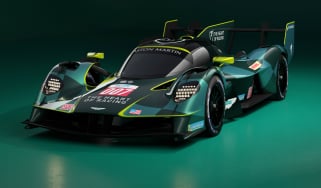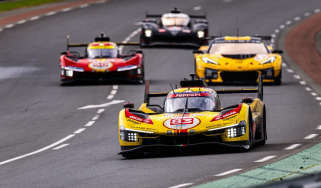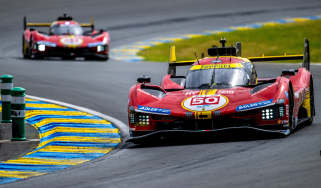Mazda 787B: the anatomy of a rotary Le Mans icon
Mazda’s screaming rotary underdog is one of Le Mans’ most iconic winners. Three decades on, there’s still magic in car no. 55
Some cars have a special kind of aura around them, don’t they? We know, rationally speaking, that they’re an inanimate set of components, a collection of metal and rubber and composite. Yet we also feel, sometimes, that there’s something there; an encapsulation of the spirit of the designers and engineers who created them. A soul, perhaps.
The Mazda 787B is one of those cars. The car that won the 1991 Le Mans 24 Hours as an unfancied underdog, the first Japanese car to do so and, as yet, the only rotary-engined winner. That green and orange livery, the banshee-shriek engine note: it’s a car that’s inspired fans since that day and night at La Sarthe 33 years ago, and gains new ones every day thanks to its immortalisation on film, in video games and in wider car culture.
> Ferrari 550 Maranello Prodrive: the anatomy of a Le Mans GT car
Normally, the 787B is kept at Mazda’s museum in Hiroshima. In 2023, it paid only its fourth visit to the UK. Following a star turn in the winners’ parade lap for Le Mans’ 2023 centenary, it crossed the channel to take to the Goodwood Festival of Speed hill with Johnny Herbert – one of the car’s three drivers in that fairytale ’91 win – behind the wheel. In between, it was sequestered at Mazda UK’s press HQ – where we had a whole day alone with it, to pore over its details and capture them to memory card for these exclusive pictures. Even with the rotary engine silent and the car static – in a room, in Dartford – that aura was present in spades.
Mazda at Le Mans
Mazda’s ever-after association with the rotary engine began in the ’60s, when its two-rotor engine began production in the Cosmo Sport road car. The company first dipped a toe in the water at Le Mans as early as 1970, with a Mazda rotary installed in a privately entered Chevron B16 in the 2-litre prototype class. An official entry appeared four years later, powering a small Sigma prototype. Although these early encounters were bruising experiences, the company committed to racing at Le Mans long-term, learning lessons from each foray. From 1981, the works Mazdaspeed team competed every year up to the ’91 victory, designing its own cars in full from 1983 onwards – always rotary-powered.
In the mid ’80s, Mazda recruited British designer Nigel Stroud, who had spent time in F1, engineering cars for March, Hesketh and Team Lotus. Stroud had already made a name for himself in endurance racing by redesigning the Porsche 956’s chassis for Richard Lloyd’s privateer team (see evo 306). Stroud was to design all of Mazda’s endurance racers, from the 1986 757 up to the 787B.
The team had made impressive progress each year, and won the IMSA GTP class multiple times, but had never yet been a factor in the fight for outright victory. On the eve of the 1991 race, the pre-race talk was of Jaguar, Peugeot, Porsche and Sauber-Mercedes. Few commentators viewed Mazda as a serious threat. But, internally, the Mazdaspeed team had resolved to go for broke. Both cars had retired in 1990 after interrupted testing. This year, they were ready. Regulation changes would outlaw the rotary engine the following year: it was all or nothing for the 787B.
Chassis, bodywork and aero
Compared with the ultra-long-wheelbase prototypes of today, the 787B looks so tiny, so neat, so perfectly proportioned. All of Stroud’s Mazda sportscars had the same basic shape and architecture, with a monocoque chassis and pull-rod front suspension. The 787 – and 787B evolution – continued that theme. Whereas Stroud’s earlier Mazda monocoques were made of aluminium honeycomb, the 787 had a full carbon composite chassis, manufactured by British outfit Advanced Composite Technology Ltd. A plaque tucked away on the passenger side states this car is 787 No. 5 and was made in Heanor, Derby, England.
One of the trickiest things about the 787’s design is that the little rotary engine is not big enough to be a stressed member of the chassis. Stroud didn’t have the luxury of a traditional, large, stiff engine to bolt to the back of the monocoque and mount the rear suspension to. Instead, the engine is cradled in a tubular subframe and its rocker-actuated rear suspension in a further framework behind.
The bodywork enveloping the carbon chassis is covered in evocatively time-worn patina. The stalk-mounted mirrors bear a thousand tiny stone chips. It’s a popular misconception that some of the original Le Mans dirt is preserved under protective film but the reality is that the protective plastic over portions of the livery has degraded and patinated over the decades. Its crazed, cracked finish looks somehow far cooler than a sparkling clean surface would.
That now-iconic orange and green livery is in deference to the team’s sponsor, Japanese textiles and clothing company Renown, and its sportswear brand Charge. The dotted lines criss-crossing the body resemble stitching, or the cut-lines for tailored fabric. Mazda entered two 787Bs and a third 787 at Le Mans ’91; this car was the only one in Charge livery. Viewing photos of the other two cars today, in their smart but forgettable white and blue livery, the no. 55 car stands out all the more. Its diagonal graphics are as much part of how you read its shape as the bodywork itself; the colours another part of the car’s aura.
Like other Group C-era sportscars, the 787B has a short body but the low-mounted rear wing behind the main bodywork gives it long-car aero. Although the 787B was Japan’s first ever Le Mans winner, we Brits can take a fair bit of national pride from it too; aside from the chassis being built in Derbyshire, the 787’s aerodynamics were honed partly at MIRA, where Stroud had occasional access to the wind tunnel.
Engine and transmission
Engine cover removed, Mazda’s 654cc x four-rotor R26B engine is so low and so small (although it counters its compact height by being deceptively long) that at the very first glance the engine bay appears empty.
In 1989, Mazda senior executive officer Yasuo Tatsutomi asked driver Pierre Dieudonné what they needed to win Le Mans. When Dieudonné replied ‘another 100bhp’, Tatsutomi vowed that for next year’s race, they would have exactly that. This meant taking the power output to more than 700bhp, while simultaneously reducing fuel consumption to remain competitive.
Engineer Yoshinori Honiden was asked – or told, perhaps – to lead the engine redevelopment team (in addition to his usual duties developing the engine for the new Cosmo road car). The demand came ‘like an order from God,’ he later said, explaining in Dieudonné’s marvellous book, Never Stop Challenging, that Mazda’s newly introduced CAD technology was not available in the firm’s working hours; that meant working nights, weekends and holidays. ‘Young engineers sacrificed their free time and private lives during that period; they ate nothing but pre-packed noodles,’ Honiden-san said. ‘It was very hard for me to impose this on them.’
Only one test bench at Mazda was capable of handling 700bhp, and today’s computer tools and simulations didn’t exist. Honiden-san’s team made a single-rotor prototype engine for evaluation on their smaller dynamometers, then travelled to use the test beds of different teams based around Fuji and Suzuka circuits, and called in favours at petrol companies. Sofa-surfing with dynos.
They really did achieve the impossible goal, or very close to it: for 1990 the 787 put out 703bhp at 9000rpm, and 420lb ft at 7500rpm. The 787B the following year was no more powerful (and ran at around 680bhp at Le Mans to save fuel, with a rev limit of 8500rpm in race trim) but had a bit more torque: 448lb ft at 6500rpm. Some of that extra oomph came from a new variable induction system with longer inlet trumpets, completely linear rather than the old car’s stepped arrangement, along with an altered injection design and a revised three-plugs-per-rotor ignition system. In the space of six years, Mazda’s Le Mans racers had gone from less than 300bhp to more than 700.
The engine could be monitored from the pits with real-time telemetry, the 787B being one of the first endurance racing cars with such technology. The oil filler top-up cap is located handily at the centre of the engine cover, ready for access at a pit stop. In actuality the car ran throughout the 24-hour race with just one top-up. And one headlamp bulb change.
As with all of Stroud’s Mazda racers, the gearbox was a rotated version of the Porsche 956 and 962 ’box. A five-speed manual with synchro, it was bigger and heavier than needed but, crucially, had proven reliability. As with other Le Mans cars of the era, there was a 100 per cent locked spool diff in place of a regular differential: less chance of breaking in 24 racing hours.
Brakes, wheels and tyres
Another first for the 787B: the first car to win Le Mans with carbon brakes. They gave a huge advantage in the braking areas, but were uncharted territory in terms of race-long reliability. Hugely expensive too, in a project where every yen was counted.
Together with the variable intake system, enhanced downforce and revised suspension for larger wheels, the carbon brakes (and a carbon clutch, too) were one of the main differences between the 787B and the previous year’s 787. The brakes reached more than 800deg C, so the B’s hub carriers had to be made from steel instead of the 787’s magnesium alloy.
Both 787Bs needed a (scheduled) brake change during the race, with new front discs and new pads all round for breakfast on the Sunday morning. Aside from a precautionary wheel bearing change, the cars ran like clockwork.
This car is still on its original wheels. Rays, the supplier, no longer makes them. Since they’re made from magnesium and 33 years is some way past the typical point at which magnesium becomes brittle, this could have a bearing on whether Mazda is able to continue running the car. If it does, it may need to commission new ones (which won’t be cheap).
The cockpit
To my eternal thrill, I get to climb behind the wheel and ‘drive’ the 787B as we carefully push it into a different position for photography, its slicks squeaking on the floor, my trainers slightly too wide for the tightly spaced pedals. It has a faint but evocative and vaguely intimidating scent of racing fluids and composites.
You sit in front of a digital Pi rev-counter and data display, with a round, almost button-less three-spoke steering wheel. A relatively large wheel, because there’s no power steering. Imagining the fitness you’d need to manhandle it around Le Mans over a double-stint (or a triple-stint in Herbert’s case, as we’ll come to shortly), through the high-downforce curves, over the chicane kerbs and sparring with other cars is a daunting thought.
The angular carbon-Kevlar dashboard has some smaller ancillary LCD displays and a mix of toggle switches and rotary dials for confusing-looking electronic systems. The drinks bottle holder is a fit-for-purpose solution: a bent piece of aluminium taped to the side of the chassis, labelled with a cartoon cup, doodled in day-glo orange to make locating it easier in the heat of battle.
The view ahead is a clear, unobstructed one: single wiper, domed screen, orange wheelarch-mounted mirrors on slender up-periscope stalks. I try to imagine what it would have felt like reaching the 787B’s circa 211mph top speed on the bumpy Mulsanne, engine screaming away at 8500rpm (or 9000 in qualifying), blitzing past slower traffic and trying to keep touch with the slipstream of the faster turbocharged prototypes. It’s too abstract a thought to comprehend.
There are Japanese inscriptions for good luck, one below the chassis plate and another on the rear bulkhead just behind the seat, added in 2011 when Herbert was reunited with the car for a demo run at Le Mans.
On the outside, there are past Festival of Speed stickers just below the fuel-filler: 1999, 2011 and 2015, when it was driven by evo’s own Richard Meaden (and a certain Valentino Rossi).
Driving it
evo caught up with Herbert at Goodwood 2023, wearing his original Mazdaspeed suit while being mobbed for autographs after driving the 787B once more. How was it?
‘Good! Exactly as I remember it last time I got in it, and the time before that, which was when we won. It’s got a nice feel, because the engine’s super-smooth. It’s like a piece of silk. The Mazda Wankels always had that character, from the moment you start them.’
The key part of the 787B’s powerband is spread from 6000 to 9000rpm, a usefully wide range, and unusually so for a race engine. ‘The powerband is very linear but it’s not very strong; there’s no torque whatsoever,’ Johnny says. (Hopefully Honiden-san and his nightshift development team aren’t reading.) ‘But it was nice, a very good car for Le Mans because it’s so smooth and progressive. I never once had the back kick out. That’s something that puts a smile on your face every time you get back in it.’
The 787B couldn’t match cars such as the turbocharged Sauber-Mercedes C11 for straight-line speed, but tellingly, with a lighter weight limit (845kg versus 1000kg for the Mercs, Jags and Porsches) and its carbon brakes, it could look after its tyres better.
‘The car’s still got very good feedback, which is what I remember from when we raced it,’ Herbert says. ‘It didn’t have the most downforce, it wasn’t the quickest, but you could push it to a very high level with the grip we had, and we could do that all the time. It’s probably one of the very early days of pushing to nearly 100 per cent all the way through the 24 hours, which now is the norm.’
Does he feel the aura around the car too? ‘That’s what’s lovely: people’s heads turning when they see the car. Some people have said to me, “I’ve only come here to see this.” Then the young generation are seeing it probably for the first time, and the noise it makes, that makes it special as well.’
The side exhaust’s shriek (and the flames it spits) have gone down in racing folklore. What does it sound like inside the cockpit? ‘It’s not as bad inside,’ says Johnny. ‘I always wear earplugs, and it’s not bad bad; it’s worse outside. Much worse.’ At Le Mans, that piercing shriek meant Herbert couldn’t sleep during the night, one ear always listening out for the car’s wail, to know it was still in the race. A midsummer night’s scream.
All three team-mates in car no. 55 were current or former F1 drivers: Britain’s Herbert, Belgium’s Bertrand Gachot and Germany’s Volker Weidler. The other two Mazdas couldn’t fight at the front: the second 787B, car no. 18, had to watch its fuel consumption as it gambled on a shorter top gear, expecting rain which never came, while the older 787’s mission was purely to finish. They would cross the line 6th and 8th respectively.
As morning dawned, Sauber’s silver Mercedes C11 led with the no. 55 Mazda in second place and a trio of Silk Cut Jaguar XJR-12s in hot pursuit. With less than four hours to go, the leading Mercedes pitted with water pump failure. The race was now Mazda’s to lose. The Jags had to save fuel; they’d assumed the Mazda was bluffing and couldn’t keep up its pace. But, as Herbert explains, Mazda opted to save fuel on the straights but enabled the trio of F1 pilots to push virtually as hard as they wanted in the corners.
At his last stop, Herbert and the team (including consultant Jacky Ickx) decided not to change drivers: so close to the end, and with Johnny in a groove, it felt more of a risk to change anything. Having triple-stinted in the hot cockpit, sleep-deprived and suffering from mild food poisoning to boot, Herbert collapsed over the 787B’s engine cover after taking the flag. While team-mates Gachot and Weidler stood on the podium, Johnny was on a drip in the medical centre to rehydrate. (When he drove the car again at Le Mans in 2011, the team ushered him onto the top step for a 20-years-belated podium photo.) When the engine was stripped, wear was found to be ‘almost non-existent’ with just 20 microns worn from the apex seals on the rotor tips after 3000 or so racing miles. It could theoretically have raced around the clock once again.
As a recession hit Japan, Mazda withdrew from world motorsport at the end of 1992 but the 787B remains a talismanic creation, inspiring engineers too young to be there at the time but charged with similarly huge engineering challenges to overcome and problems to solve. Here at Mazda’s Dartford HQ, a steady stream of folk come by to see the car, to photograph it, to spend some time in its presence.
And maybe there’s more to its aura than history, success and a famous livery. The 787B has one more secret to reveal. To switch the headlights on for a photograph, we need to remove an access panel to connect the battery. On the reverse side of the panel is a hidden handwritten note. Dated 16 August 1991 and signed by a small group of the 787B’s original engineers, its message roughly translates from Japanese to English as: ‘Look after it, because it is our soul.’
This story was first featured in evo issue 318.





